#Land Mapping software
Explore tagged Tumblr posts
Text
From stress to success! Digital Land Management System - LAMS is the hero we all need! 😎
#land management software#land management solutions#land asset management software#land management system#land acquisition software#land management system software#Land software#Land Allotment Software#Land Information management System#GIS based land management System#Land Records Management System#Land Mapping software#Land Leasing Software#digital land record#Land Lease Management Software#Digital Land Management System#friday work meme#funny work meme#office memes#office memes funny#best office meme#software development memes#software dev memes#software demo meme
1 note
·
View note
Text
How CAD Technology Transforms Accuracy and Efficiency in Land Surveying

Land surveying is a critical process in the fields of construction, engineering, and land development. It involves measuring and mapping the terrestrial or three-dimensional space to determine boundaries, land features, and property lines. Traditionally, land surveying relied heavily on manual techniques and rudimentary tools, leading to time-consuming and often error-prone results. However, with the advent of Computer-Aided Design (CAD) technology, the landscape of land surveying has transformed dramatically. CAD has brought about significant improvements in accuracy and efficiency, revolutionizing the industry. In this blog post, we will delve into the various ways CAD enhances land surveying and explore its benefits in detail.
The Role of CAD in Land Surveying
CAD, or Computer-Aided Design, is a technology used for creating, modifying, analyzing, and optimizing designs. In the context of land surveying, CAD software helps surveyors create detailed and precise maps and plans of land areas. The integration of CAD in land surveying involves the use of specialized software that allows surveyors to input data, process measurements, and generate accurate digital representations of physical spaces.
Enhanced Accuracy
One of the most significant advantages of CAD in land surveying is the enhanced accuracy it provides. Traditional surveying methods often involved manual calculations and hand-drawn maps, which were susceptible to human error. In contrast, CAD software offers tools that automate many of these processes, reducing the likelihood of mistakes. Here are some ways CAD improves accuracy:
1. Precision in Measurements: CAD software can handle and process complex mathematical calculations with precision. Surveyors can input raw data collected from the field directly into the software, which then accurately converts these measurements into detailed maps and models. This eliminates errors associated with manual data entry and calculation.
2. Detailed and Scalable Maps: CAD allows for the creation of highly detailed and scalable maps. Surveyors can zoom in and out without losing accuracy, enabling them to examine specific areas closely and ensure every detail is accounted for. This level of detail is crucial for identifying potential issues and making informed decisions.
3. Real-Time Data Processing: Modern CAD software can process data in real time, providing surveyors with immediate feedback. This capability allows for quick adjustments and corrections in the field, ensuring that the final survey is as accurate as possible.
4. Integration with GPS and GIS: CAD software often integrates seamlessly with Global Positioning System (GPS) and Geographic Information System (GIS) technology. This integration allows surveyors to import precise location data directly into their CAD models, further enhancing accuracy and providing a comprehensive view of the surveyed area.
Increased Efficiency
Efficiency is another key area where CAD excels in land surveying. The traditional surveying process was labor-intensive and time-consuming, often requiring surveyors to spend days or even weeks in the field. CAD technology streamlines many aspects of this process, leading to significant time savings and increased productivity. Here’s how CAD boosts efficiency in land surveying:
1. Automated Data Processing: CAD software can automate many of the repetitive and time-consuming tasks involved in land surveying. For example, it can automatically generate contour lines, calculate areas and volumes, and create cross-sections. This automation reduces the workload on surveyors and speeds up the overall process.
2. Simplified Data Management: Managing large amounts of data can be challenging, especially in large-scale land surveying projects. CAD software offers robust data management tools that allow surveyors to organize, store, and retrieve data easily. This simplifies the workflow and ensures that all information is readily accessible when needed.
3. Collaborative Capabilities: CAD software often includes collaborative features that enable multiple team members to work on the same project simultaneously. This collaborative approach enhances communication and coordination, leading to faster completion times and fewer misunderstandings.
4. Efficient Fieldwork: With CAD, surveyors can use mobile devices and specialized equipment to collect data in the field more efficiently. This data can be uploaded to the CAD software on the go, reducing the need for repeated site visits and minimizing downtime.
Visualization and Analysis
Visualization and analysis are critical components of land surveying, and CAD technology excels in these areas as well. The ability to create detailed visual representations of surveyed areas and perform in-depth analyses is invaluable for surveyors, engineers, and developers. Here are some ways CAD enhances visualization and analysis:
1. 3D Modeling: CAD software enables surveyors to create three-dimensional models of land areas. These 3D models provide a realistic representation of the terrain, allowing for better analysis and planning. Stakeholders can visualize the land’s topography, identify potential challenges, and make informed decisions based on accurate data.
2. Overlaying Data: CAD allows for the overlaying of different types of data on a single map. For example, surveyors can combine topographical data with utility lines, property boundaries, and environmental features. This comprehensive view helps in identifying potential conflicts and planning accordingly.
3. Simulation and Scenario Planning: CAD software can simulate various scenarios and predict their outcomes. For instance, surveyors can model the impact of construction on a particular area, assess potential drainage issues, or analyze the effects of environmental changes. This capability aids in proactive planning and risk management.
4. Detailed Reports and Documentation: CAD software can generate detailed reports and documentation based on the surveyed data. These reports can include measurements, calculations, maps, and 3D models, providing a comprehensive overview of the surveyed area. Such documentation is essential for legal, regulatory, and planning purposes.
Cost Savings
The improvements in accuracy, efficiency, and visualization brought about by CAD also translate into significant cost savings. By reducing errors and streamlining processes, CAD helps surveyors and their clients save money in various ways:
1. Reduced Rework: Accurate surveys mean fewer mistakes and less rework. Errors in traditional surveys often led to costly revisions and delays. CAD minimizes these errors, ensuring that the project stays on schedule and within budget.
2. Optimized Resource Allocation: Efficient data processing and management allow surveyors to optimize the use of resources, including time, labor, and equipment. This optimization leads to cost savings and better project management.
3. Minimized Site Visits: With the ability to process and analyze data remotely, CAD reduces the need for multiple site visits. This not only saves time but also reduces travel and labor costs.
4. Improved Decision-Making: Accurate and detailed surveys provide valuable insights that aid in decision-making. This leads to better project planning, fewer unforeseen issues, and more efficient use of resources, all of which contribute to cost savings.
Future Prospects of CAD in Land Surveying
As technology continues to advance, the role of CAD in land surveying is expected to grow even more significant. Emerging technologies such as Building Information Modeling (BIM), drones, and LiDAR (Light Detection and Ranging) are being integrated with CAD software, further enhancing its capabilities. Here are some future prospects for CAD in land surveying:
1. Integration with Drones: Drones equipped with high-resolution cameras and LiDAR sensors can capture detailed aerial imagery and topographical data. This data can be imported into CAD software for precise mapping and analysis. The use of drones reduces the time and effort required for fieldwork and provides access to hard-to-reach areas.
2. Building Information Modeling (BIM): BIM is a digital representation of the physical and functional characteristics of a building. Integrating BIM with CAD allows for a seamless transition from land surveying to construction planning and management. This integration improves collaboration between surveyors, architects, and engineers, leading to more efficient project execution.
3. Augmented Reality (AR) and Virtual Reality (VR): AR and VR technologies can enhance the visualization capabilities of CAD software. Surveyors and stakeholders can use AR and VR to explore 3D models in an immersive environment, gaining a better understanding of the terrain and potential challenges. This immersive experience aids in decision-making and improves communication.
4. Artificial Intelligence (AI) and Machine Learning: AI and machine learning algorithms can analyze large datasets quickly and accurately. When integrated with CAD, these technologies can automate complex analyses, identify patterns, and predict potential issues. This capability enhances the efficiency and accuracy of land surveying.
Conclusion
CAD has revolutionized the field of land surveying by improving accuracy, efficiency, and visualization capabilities. The precision and automation offered by CAD software reduce errors and streamline processes, leading to significant time and cost savings. As technology continues to evolve, the integration of CAD with emerging technologies such as drones, BIM, AR, VR, and AI will further enhance its capabilities, making land surveying even more efficient and accurate. For surveyors, engineers, and developers, embracing CAD technology is not just an option but a necessity for staying competitive and delivering high-quality results in today's fast-paced and demanding environment.
#Land Surveying#outsource cad drafting services#Surveying#Land Survey#Land Surveying Software#Land Survey Drafting Services#Land Survey CAD Drafting Services#Alta Survey#Subdivision Plats#Title Survey#Pipeline Surveys#Construction Survey#Site Planning Survey#Boundary and Location Survey#Topographic Survey#Residential Mortgage Survey#Tower Survey#Radius Map#Utility survey
2 notes
·
View notes
Text
Topographic Survey Software
AutoPlotter Advanced delivers an affordable solution for everyday land surveying needs. Built on the powerful DTM engine of its Pro counterpart, it seamlessly processes data from total stations, GPS, or similar instruments. Generate professional topographic and contour maps, perform traverse adjustments, and coordinate conversion. Its built-in CAD tools let you create complete drawings, while features like instant map creation and 3D terrain views accelerate your workflow. Easy to learn and use, AutoPlotter Advanced is ideal for surveyors seeking productivity and affordability.
https://infycons.com/autoplotter/advanced/

#civil engineering and civil software#topographical survey#land survey#civil technology#cross section generation#topographic map#topographic survey#quantity calculation#software solutions
0 notes
Note
Titan LL!
Heavens, I love Titan LL.
...You know, since nobody's doing anything, I think I'll try something. Dibs!
.*.*.*.
Lost Light is named after a day of mourning.
He doesn't feel like it.
Perhaps it was a wish made upon the smallest of the youngest batch of Titans, brought online shortly before fires of revolution blazed across Cybertron and it's domains. For the mourning to be the least in the coming times. Perhaps they succeeded, but joke's on them. Lost Light may have been online through the times of grief, but grief does not touch his spark. It's another element of his surrounding, like floating rocks, clouds of solid something, solar winds, the works.
Well, for a given definition of "online", because, he, his batch and some older Titans were moored in random spots in the system, just away from Cybertron itself.
The new batch was mostly stationed in the shadows of Cybertron, in vain hopes of civil war going away quickly. But sometimes, when the fighting peaked and threatened to reach the moons, they were herded away and over to the system's edge, near the border of termination shock. There were a lot of visible stars here. And Primus, there was nothing more Lost Light liked more than those beautiful, beautiful stars.
The first Titans were sparked to carry their Cybertronian brethren beyond the embrace of their homeworld to the stars and defend them on the way. Not all Titans functioned as deep-space transport nowadays, but that was the original idea behind their frametype. Wayfarers.
And just when Lost Light started to go mad between moorings and itched to stretch his warp drive, because Primus and Unicron conspired to punish him specifically for his hubris, the Quintessons struck.
And Titans of Cybertron, eternal guardians they are, stood as the first line. While the little ones below scrambled around and got their priorities and slag-all in order, they stood. And together they withstood successfully. Neither Cybertron nor any planet in it's system fell to the Quintessons. It was not a clean victory, and Quints broke the lines to land incursions, but the Titans weathered enough that the little ones on the grounds were not overwhelmed. They endured the first of storms.
In the end of the beginning, the home system was safe, the civil war was over, and the Titans under the newly united Cybertronian High Command were partially reassigned to the outer fronts.
Now, Lost Light is a tiny Titan. An unusually tiny Titan by Titan standarts. He heard it was because there was a mix-up of vessels for reforging into Titanframes, and his was made from a late shipment two classes below specification.
His largest configuration houses in theory a thousand crewmembers. He prefers his smallest, which should hold above a dozen, but he does not have even a dozen of a crew anyway. He is still a Titan, and can comfortably rip into one, two, three Quint ships, but he cannot withstand a dozen, and Primus below, Quint ships in outer space come in waves and swarm like the squids they are. Instead, in this war he does he does best of what he does - he runs. He is small, his warp drives and bridge generators are the best among his batchmates, and he is fast. So he runs.
There's no Quint blockade that can stop him. Perhaps his cargo hold is not the largest, but if he is given a delivery, he will deliver it as soon as possible, come Pit or high tides. There's no escort craft that can keep up with him (and let's be honest, they are already understaffed enough that they simply can't find proper escort for his size), so he runs alone. If the Prime himself needs an express delivery, Lost Light is the Titan for the job.
He sees a lot of stars on his runs. He is pretty sure some of them are at least unclaimed, and some may be uncharted at all, so he marks them all on his maps. For later! Once the war ends, the beautiful, beautiful stars are his! He amasses a lot of maps, colors and marks them in the brightest hues his software comes with.
And some little ones even ask after the maps. Not like he hides them or something.
So, when the Prime calls, he comes.
Prime waits for him in the hanger personally. Together with the usual retinue, very much less usual very large pile of maps, boards and documents, a Perceptor hidden behind the pile of stuff (Xanthium talks about her favorite gunner a lot, when they have time to catch up), some twitchy engineer and his frequent passenger of express ferry Head Tactician Prowl.
Who has something very tiny enthusiastically crawling on him. Something so tiny, he has to recalibrate his inner and outer sensors for recordicon contact. His optics were hit in bot mode by rocks larger! Which were sometimes crawling with assorted space crustaceans! Come to think of it, thos crustaceans moved similarly...
And, because he is better at acceleration than braking, first thing Lost Light does is voice this observation.
"Prowl, sir, you've got crabs"
...
That was a start of a wonderful working relationship. Once they calm the tiny organic down from laughing, that is. It's name is Jazz, and it needs a ride home. Home which is besieged by Quintessons, and likely is near a fortified outpost, if not a starbase.
Strictly speaking, usually Titans are kept apart from organics, because they are usually very small, and tend to rot and fossilize. But since Lost Light is also very small, he got a direct invitation to an organic planet and immediately engaged his internal environmental system to produce enough oxygen. This is a chance of a lifetime!
Which brings him to his current... Problem?
The thing is, Jazz apparently has comrades. They pilot simulacrum frames specialized in Quint killing, which is very much respectable. And Lost Light's alt-mode's hangar bay may be a little tight in this configuration, but still compatible with them.
The issue is, one of those simulacrums which Lost Light got to shelter, a pleasantly painted one (flame patterns are always in vogue! No matter what anybody says!), appears to have broken down. Which made the organic inside very upset. At least he thinks it's upset, he is not very good at reading organics. Those "humans" do have fields, but they are very dull in comparison to Cybertronian ones.
The little organic with great taste is shouting what appears to be obscenities at unresponsive frame and alternates this with begging. Lost Light is floundering in his processor. The organic performs some indecipherable actions towards a fuel line of some sort with a tiny wrench. He's been at it for hours. None of the others from Jazz's makeshift warband returned yet.
This means Lost Light is responsible as the hosting Titan. Lost Light is usually alone. He does not quite know how to host other Cybertronians for prolonged periods of time, let alone organics. He hopes he maintains a nice oxygenated atmosphere.
He cannot watch this anymore. He has to gather all his confidence in his circuits and do something. Like talk to an organic without Prowl or the twitchy engineer (Swear? Swole? Swire? Swalter?) present. And, well, he'll figure how to decelerate later!
"Little one, do you require any assistance? I do have an internal welder somewhere..."
The organic startles, almost falling from it's precarious perch at the simulacrum's locked elbow joint, catches itself in time, and glances around. Then it glances up. And around again.
"I haven't hit my head that hard, yes? Is there someone here?"
"Well, yes? I mean no offence, but you're inside me"
Silence answers him, quickly broken by laughter. He remembers Jazz laughing. It is a similar laugh. He thinks he likes this laugh more.
"Well, I did not expect the ship to be speaking too. I really should not be surprised after this whole month"
At least the organic isn't despairing anymore? Lost Light thinks he can see a smile on it's face if he strains the camera.
"Technically, I'm a Titan. I'm a ship in the same way Deadlock is a,,, what you call small ground vehicle... Car? If I want to, I can be a building."
"Wait, but if you're the ship... How big do you guys come?!"
"Very. Now, little one, do you want my welder or not?"
Another wave of laughter follows.
"I do have a name!"
"You did not introduce myself"
"Cheeky. And yet, you did not introduce yourself either, big ship"
"My designation is Lost Light, and I'm the best Titan Courier this side of the galaxy"
The organic seems to finally locate his internal camera and so it points at it with it tiny wrench. Lost Light thinks it likes it's smile too.
"Well, nice to meet'cha, Lost Light. Name's Hot Rod. Now, about that welder..."
Lost Light rummages in his inventory for his favorite welder, mountable on a cargo manipulator. It is surprisingly elusive.
"I have it, I have it.... somewhere. It's been a long time since I patched up myself."
"...You patch yourself up often?"
"Nowadays not much, I'm a very good runner, and... Aha! There it is!"
Hot Rod look very, very happy to see the welder-wielding cargo manipulator. He is so much smaller than the tiniest little ones he carried. He reminds Lost Light of something that escapes his processor.
"Thanks, big ship. I hate ruptured lines. God knows when Ratch and that Swerve guy will be back"
"I'm not that big, you know. And I'm glad to be of assistance"
Despite pointed critique from the organic called Ratchet later on, Lost Light considers his skills with a welder in his internal cargo manipulator arms to be above average.
Hot Rod thinks so too, and ire of a medic shared is misery halved in Lost Light's books.
And then it hits him.
He reminds Lost Light of those beautiful, beautiful distant stars.
Lost Light prepares a very tiny datapad for a very big map.
.*.*.*.
...And here it is. I got possessed. Guest-starring my basic knowledge of astrophysics and bad jokes.
OOOOOOOOOOOHHHHHHHHH I LOVE THIS TAKE ON THEM SO MUCH
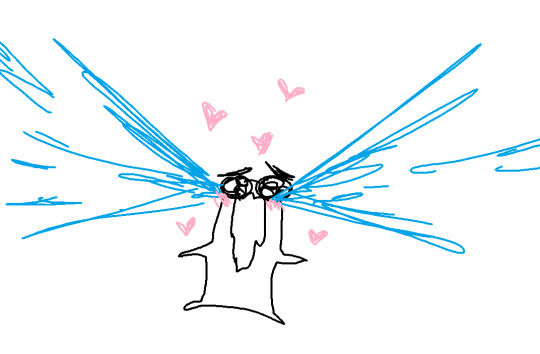
403 notes
·
View notes
Text

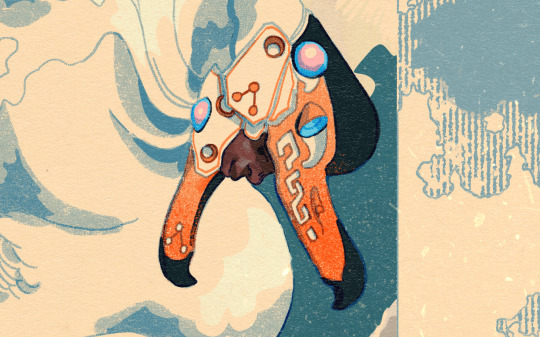
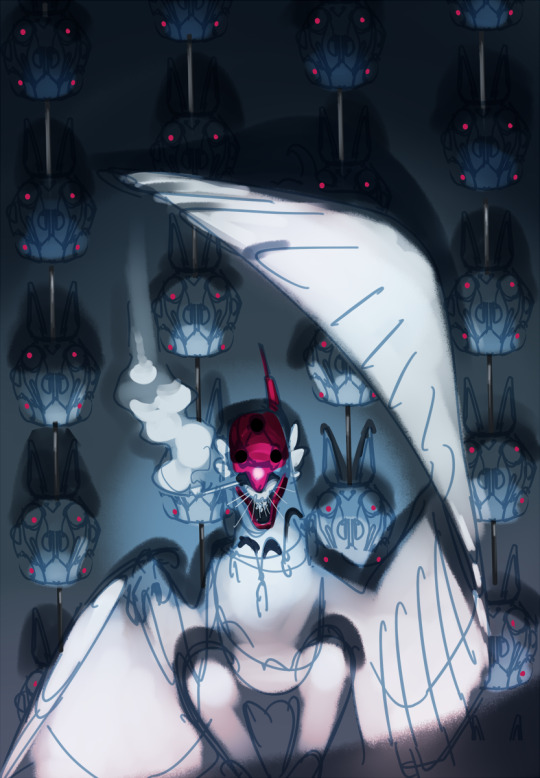
visored longwing harpies & the hall of faces
I did say there was no exclusive global culture on Siren shared by humans of a certain body type, and I lied, because there is One.
The early settlers on Siren were the unaltered human workforce of a certain megacorporation. While an almost unlimited budget was poured into the dodgy gene programs, since that was why they chose to settle a planet so far out of the reach of The Authorities, everything else was done pretty cheaply, including the settling itself. In order to map out their new home planet, incredibly cheap mass-produced aircraft were used by pilots. These aircraft could be made quickly and easily at the settlement site because they lacked a flight computer or any real sensors - or any equipment at all in the cockpit. Rather than a multitude of different equipment loadouts on an aircraft that would take time and effort to swap out or maintain, the pilots instead used these visors which were universally compatible with the one-size-fits-all aircraft. It's kind of like how it's easier to just carry a phone around with a calculator app than it is to carry a phone and a calculator, even if the phone app calculator experience sucks by comparison.
The visors were the real expensive kit, each custom built to a pilot's exact needs and flight style, and they were built to last. the aircraft fell apart in the following centuries but the visors remained, hyperlight plastic powered by the planet's native star, and something interesting happened. The remains of the first settlement were largely inaccessible to anyone but longwing harpies, and these harpies had the right head shape to fit the visors. Many of the pilots had filled their visors with video and photo files from home, from Earth, like a worker decorating his cubicle with photos of his family. Some had been decorated on the outside, as well, resembling birds. The harpies that found the visors obviously tried to use them. They found themselves experiencing visions of strange worlds, recordings of long-dead pilots and ATC, and found that each visor can interface with every other one, no matter how far apart. Each visor came with its own callsign, its own name, which has remained for thousands of years - and because of this, each visor is considered by the cultures of Siren to be a named character with a distinct personality (eg. the swan visor was cygnus2, it is known now as Signastoo)
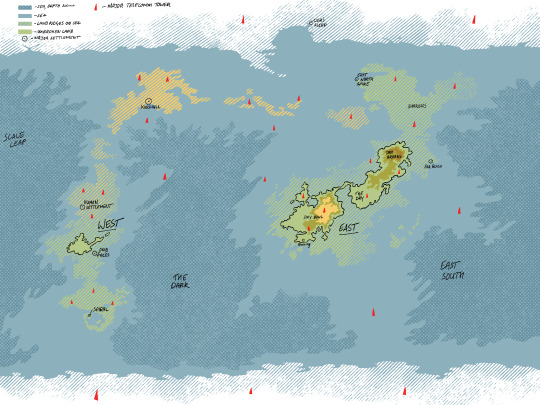
I keep posting the map and it needs to be redrawn but essentially every red triangle is an ancient telecomm tower. These became the only remaining waypoints on the visors' HUD and mapping software, meaning that 1. a true global culture could emerge, with longwings gathering at these sites, and 2. visored longwings became the gold standard for navigation on Siren. In a world that is basically just water, that's a big deal.
There exist only a few thousand visors (about 3k I'd say). The unused visors are kept in the Hall of Faces, the ancient aviation bay at the first settlement in West. Because of how water levels and land structures have changed over the years, this building exists on a mesa that rises another few thousand feet out of the water, with sheer sides, and is utterly inaccessible to anyone but a longwing harpy. When a visored harpy dies, the visor is returned here. If you want to claim a visor, you need to hold an interview with one of the elders at the site, who will test you rigorously to see if you can inhabit the character of one of the visors. If not, too bad. If you do get it, it's yours until either you die or you do something considered 'out of character' for the wearer of that particular visor. It is DEEPLY discouraged to steal a visor off anyone because it would be largely impossible, given how they all can communicate (imagine a gigantic worldwide discord server where the location & name of every person is known at all times... the drama is likely insane but at least if someone steals a visor, everyone will know about it)
not every longwing desires a visor because it comes with a lot of responsibility alongside its automatic prestige, and you can't really give it up once you have it. also there's always the possibility of being diagnosed with a super annoying, glitchy, or hated visor character lol. but among the roughly 2700 visored harpies on Siren there does exist a global culture exclusive to them. they chat to one another long-distance, engage in closed-practice ceremonies where they all get high and look at videos of Earth, and essentially become a class outside the mundanity of normal life on Siren. to the rest of the population, they basically become telepathic wizards
Terwyef's visor (first pic) is called Scrappercharlee and is one of the more common models, tho it has been decorated over the years with extra bits. Scrappercharlee is a bit busted and half the HUD is missing. Miakef's visor (second pic) Signastoo is one of the very fancy and well-known ones, it's shaped like a swan's head and likely belonged to a high-ranking pilot who could afford a bit of frippery and showmanship back in the day. Birds do not exist on Siren and harpies are mammals so the swan itself is symbolically meaningless, but the bird-style visors introduce the idea of 'a bird' in the abstract, and this has been imbued with its own form of meaning by harpies.
330 notes
·
View notes
Text
A bunch of brainworms about dlc. Speculations, theories, my personal opinion, which I think I will stick to until the release of dlc.
Miquella.
(1) The main plot is that we go after Miquella. It is not yet very clear for what purpose and who sent us there, but judging by the voice at the end, it could be Ranni or Melina, or even Miquella himself. Voice is quite feminine.
(2) Miquella is likely to be our companion, as Melina was, or we will follow some messages from him, maybe meet his followers who will guide us, since the announcement says that we will be "guided by Miquella" and "meet others who follow in miquella footsteps".

(3) I'm not sure if we will have the opportunity to fight with him or not, but the last scene where we see the first shot of him where he's literally SHINING, can be both the ending cutscene of the dlc and the beginning of the bossfight.
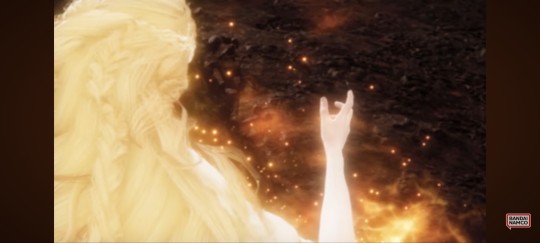
(4) It's likely he will look the same with his first concept art appearence, because the hairstyle with braids and his skin, they are very similar.

(5) If this tree in the Shadow realm is the Crucible of life that I explain below in my theory, it is quite possible that Miquella came to this world for obtaining its power or something like that, it is also quite possible that he goes there because he knows that Marika has hidden something in this world, something very important.
(6) Overall, Miquella's trip to these lands seems like a pretty desperate move to me. He literally commits a very terrible sin by "divesting himself of his flesh, his strength, his lineage. Of all thing Golden". It sounds like he finally broke all his connection with the golden order and his family, including his blood connection with MALENIA that sounds crazy, and he also renounces his power, as I understand, magical and which is hidden in his blood. In my head, it looks very similar to what Ranni did, killing her body and moving her soul into a doll. It's just that Miquella killed his body or left it and moved his mind into this hidden world with the help of the power of sleep and dreams. I repeat, it seems to me some kind of desperate last step, perhaps he felt that his transformation was interrupted by Mogh and was no longer possible to complete because of his poisoned body, maybe he felt that his tree had died or something like that.

(7) Most likely, based on the words that Miquella is "awaits the return of his promised Lord", he cannot leave this realm on his own, either because he is captured by someone, maybe Messmer, either because his initial plan failed and he simply does not have enough power to return. So he's waiting for the promised lord. Here we have at least two options:
- This opens for us consort ending, but with Miquella, he will essentially be an alternative for Ranni, because he is also an Empyrean just with other purposes. And can replace Marika as a vessel of the Elden ring like Ranni. This is also supported by rumor that From software wanted to make another extra ending - the Age of Abundance, but either they cut it out at the end, or maybe abandoned the idea.
- I also saw the option that it could be Godwin as promised Lord, to whom Miquella could bring the true death, it can be the reason why he came to this world initially.
World.
(1) We are going into the world of shadows and it seems that this is not Miquella's dream or the Erdtree afterlife or something else, as many assumed earlier, but some kind of hidden realm that is not accessible to ordinary people and may be either under the map, or as some people suggest, either be at the intersection of all towers where we activated great runes, behind a large cloud on the map.


(2) Very important, some kind there once was Marika in this shadow realm, as mentioned in the summary of the game's plot in the announcement: " a place obscured by the Erdtree where the goddess Marika first set foot". Perhaps this world was her home before she became a goddess, or she ruled these lands before they were hidden, apparently during some kind of war: "a land purge in an unsung battle". It was quite possible that it was the war with giants, given some of the symbols hinting at it in Messmer + flame magic.
(3) Looking at the baldachin over the tree and keeping in mind its similarity to Marika's chambers in the capital before Morgott, I think that perhaps Marika herself made these lands forbidden or closed from others with this baldachin barrier, so the theory that Messmer may be an unwanted or forgotten demigod-child of Marika, left in this shadow world, as Marika's dark secret, has some basis. This is also hinted at a special dungeon in Leamgrave, Impaled Catacombs, thanks super lore guys in twitter!

(4) Speaking of the secrets of Marika, the tree at the center of this realm. I have a lot of thoughts about this. It may be wild, but I assume that this could be the Crucible of life or what's left of it. That golden liquid that flows down is the power of the Crucible that goes out into the world. In the Lands between, due to the overwhelming influence of the Erdtree and the Golden order, its power is almost not felt, and can only manifests itself in the birth of Omen children, but in THIS world, the world of shadows, we see signs of the influence of the Crucible: horns, spells and etc in almost all creatures. Thus, Marika could lock the tree in a separate dimension, hoping that it would soon die on its own and its influence would finally dry up, but it is still alive. Or, of course, it can simply be a reflection of the Erdtree in the dark world, if we consider the theory that the world of shadows is a reflection of the real world. I definitely don't think it's Miquella's tree, because it has absolutely no reason to be one.

(5) I also want to note the time in this story, chronology is quite a mess in Elden ring in principle, but according the trailer, a significant place in this shadow world is occupied by some faction associated with Saint Trina, and therefore with Miquella. That suggests that either Miquella came to this world quite a long time ago to be able to organize and build his own order or something like that, either time goes faster there than in the main game, which is quite interesting.
(6) Speaking of factions in this world, there are at least a few: the faction of Saint Trina (we saw a knight who fought with some kind of sleepy magic, although it could be a gravity spell because of lightning🤔) but there were lilies on his armor🤷), we also saw someone very similar to a Carian woman in a room similar to Raya Lucaria, more than that there are architectural elements of the Carian architecture and the architecture of Sellia, which means Kariya faction. Almost forgot, we also can see Moon in one shot.
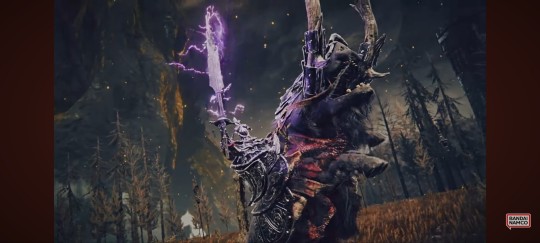

Perhaps Messmer has his own faction, most likely ruling in this dimension. And also there are some coincidences in how the branch that the elderly man pulls out of his body looks, with the shape of candlesticks that some enemies fight with and the symbol on the black knight in the form of a pointed branch or rune. These all symbols are black and golden. Probably this is some kind of pro-erdtree faction, followers of the Great order and Marika. The color scheme echoes Marika and Maliket at least. From the voice lines we can assume that in this shadow realm there are followers or Erdtree faithful and those who opposite them, perhaps it can be even active conflict in present time and wars in the past.
Messmer.
I see for myself two working variants of his origin:
(1) Marika and Radagon. Since he has a rather distinctive appearance, the theory of butterflies in the game, where the smoldering butterflies actually refer to him, and not to Melina; more than that when he addresses to his mother and talks about Lordship, I don't think anyone other than Marika has the authority to make a man the Elden Lord; and in the scene with him, there is a statue of a woman with a child behind his back, the woman is difficult to see, but by the location of the bracelets on her arm, you can compare her with the statues of Marika in the main game;
(2) Gloam-eyed queen. The portrait of a woman with an elderly man refers to this, the woman in the picture with dark hair, she holds her hand on her stomach as if she is pregnant; Messmer has some similarities with the "children" of Gloam-eyed queen - the apostles; he uses a very strange black and red flame.
(3) The theories that Messmer is some part of Miquella or he himself look strange to me, considering that we have known for a long time from the main game that there was some other child of Marika that we don't know about, we just used to think this was Melina. According to the announcements, although indirectly, we can assume that this shadow world and Messmer existed for a long time, perhaps even before the birth of Miquella and Malenia, probably Messmer was exiled there for blasphemy or something like that.
(4) l also don't think Messmer is Miquella's son or Mogh and Miquella somehow had a child together. I think all the influence of Mogh in this dlc will be directly related to his influence on Miquella. I don't think he's affected the world around him, everything that happens in this world, I think should be the influence of the Crucible of life and Messmer directly, perhaps some other forces, but not Mogh.
I'm sorry all of this is such a mess, like in my head after trailer. I'd be glad to see your comment and theories too, maybe you can challenge some of my theories, it gives them extra development and I could add something later. So thank you for attention.
#shadow of the erdtree#elden ring#elden ring dlc#elden ring miquella#miquella#miquella the unalloyed#lore
77 notes
·
View notes
Text
Finally playing Elden Ring and wow it has exceeded my expectations as a designer. From the ways the game handles difficulty scaling with summoning ashes, its diverse methods of player expression via a more comprehensive magic system, and the map design all have me impressed.
But I've got one (singular) thorn in my side about Elden Ring that has made me think about the pros and cons of... prose and cons.
So, From Software games have a reputation for cryptic lore veiled behind equally cryptic prose, usually squirreled away in item descriptions. In past From Software games, this has mostly been an opt-in experience for Players. Want to dive into analyzing that prose to find some interesting world building nuggets? Knock yourself out. Think that's too much work? That's fine too! Since past From Software titles are linear experiences with minimal narrative player choice, one could ignore the prose-veiled lore and just enjoy the game from a mechanical and power fantasy perspective.
But just like Elden Ring is different from past From Software games in a myriad of other ways, Elden Ring is different in this regard too. On one hand, the open world nature of the game helps couch this prose in a more intense sense of discovery. Instead of walking down a fairly narrow exploration space and then being delivered these nuggets of lore, you (the player) are actively venturing out to a location because it looks interesting to you. Therefore, there's a sense of personal investment in what you find there and what you learn! And that's really cool!
But on the other hand, From Software's tendency to veil its lore in this way can sometimes work against Elden Ring's nareative design. Specifically when what you find is a who and not a what. Sometimes those NPCs you meet will want something of you that requires you to make a choice between people, factions, or even cosmic powers in the world. Now of course in any story there is bound to be hidden information to the Player, but due to how From Software lore is presented, it can be difficult for a Player to make an informed choice about the actions their character is taking.
This can lead to situations where an NPC attempts to con a Player or undermine their belief in a faction in the lands between. But due to the cryptic nature of Elden Ring's prose, these important decisions can go right over a Player's head! And if the Player doesn't know what they're getting themselves into, they might feel confused or even cheated when their character does something that doesn't match the Player's expectation of how their Character has acted thus far.
For some Players, this could manifest as the Player being ambivalent and not particularly invested in the Characters within the story. But overall this is a minor bump in an otherwise pretty fantastic game, and I wouldn't be surprised if I received comments saying that this Player experience absolutely didn't happen to others.
The easiest way to fix this would simply to be a modicum more transparent to the Player about the choice they are about to make once said choice is in front of them. That way, Elden Ring could throw as much cryptic prose as they wanted at the Player, and then when it becomes decision time, the curtain could be pulled back juuuust a little bit to give the Players key context to what their deciding to do with their character.
Hell, doing this could even expand the design space From Software has to work with regarding their quest lines! It could allow for more meaningful and interesting narrative choices on the Player's part to foster further replayability.
#elden ring#game design#video games#fromsoftware#bloodborne#dark souls#rpgs#rpg#worldbuilding#sekiro
17 notes
·
View notes
Text

[ID: A background image of a paper texture, on top of it is a landmass in the shape of a blobous land and on it are various shapes in colored outlines. Starting with a green shape labelled Numberland to the leftmost of it. above it is a larger shape thats labeled Chromava, below Numberland is another shape labeled Alphabetia thats dark red. To the right of Chromava is a small shape that sort of looks like a puzzle piece labeled Puzzos which is blue. Underneath that and to the right of Numberland is a gray circle, written underneath it is Noiset and to the right of both Puzzos and Noiset is a shape thats sort of like three petals in shape, its dark pink and labeled Petalland, directly underneath that is a large vaguely shield like outline labelled Stickoro END ID]
Working on a map of Formenta.
Numberland Land of Numbers Chromava Land of Colored Blobs Alphabetia Land of Letters Puzzos Land of Puzzles Petalland Land of Flowers Stickoro Land of Stick figures Noiset Land of Fog beings
I enjoy making maps and do so all the time in a software called Wonderdraft, its not free but I'd recommend it.
11 notes
·
View notes
Text
Ko-fi prompt from @thisarenotarealblog:
There's a street near me that has eight car dealerships all on the same lot- i counted. it mystifies me that even one gets enough sales to keep going- but 8?? is there something you can tell me that demystifies this aspect of capitalism for me?
I had a few theories going in, but had to do some research. Here is my primary hypothesis, and then I'll run through what they mean and whether research agrees with me:
Sales make up only part of a dealership's income, so whether or not the dealership sells much is secondary to other factors.
Dealerships are put near each other for similar reasons to grouping clothing stores in a mall or restaurants on a single street.
Zoning laws impact where a car dealership can exist.
Let's start with how revenue works for a car dealership, as you mentioned 'that even one gets enough sales to keep going' is confusing. For this, I'm going to be using the Sharpsheets finance example, this NYU spreadsheet, and this Motor1 article.
This example notes that the profit margin (i.e. the percentage of revenue that comes out after paying all salaries, rent, supply, etc) for a car dealership is comparatively low, which is confirmed by the NYC sheet. The gross profit margin (that is to say, profits on the car sale before salaries, rent, taxes) is under 15% in both sources, which is significantly lower than, say, the 50% or so that one sees in apparel or cable tv.
Cars are expensive to purchase, and can't be sold for much more than you did purchase them. However, a low gross profit margin on an item that costs tens of thousands of dollars is still a hefty chunk of cash. 15% gross profit of a $20,000 car is still $3,000 profit. On top of that, the dealership will charge fees, sell warranties, and offer upgrades. They may also have paid deals to advertise or push certain brands of tire, maintenance fluids, and of course, banks that offer auto loans. So if a dealership sells one car a day, well, that's still several thousand dollars coming in, which is enough to pay the salaries of most of the employees. According to the Motor1 article, "the average gross profit per new vehicle sits at $6,244" in early 2022.
There is also a much less volatile, if also much smaller, source of revenue in attaching a repairs and checkup service to a dealership. If the location offers repairs (either under warranty or at a 'discounted' rate compared to a local, non-dealership mechanic), state inspections, and software updates, that's a recurring source of revenue from customers that aren't interested in purchasing a car more than once a decade.
This also all varies based on whether it's a brand location, used vs new, luxury vs standards, and so on.
I was mistaken as to how large a part of the revenue is the repairs and services section, but the income for a single dealership, on average, does work out math-wise. Hypothesis disproven, but we've learned something, and confirmed that income across the field does seem to be holding steady.
I'm going to handle the zoning and consolidation together, since they overlap:
Consolidation is a pretty easy one: this is a tactic called clustering. The expectation is that if you're going to, say, a Honda dealership to look at a midsize sedan, and there's a Nissan right next door, and a Ford across the street, and a Honda right around the corner, you might as well hit up the others to see if they have better deals. This tactic works for some businesses but not others. In the case of auto dealerships, the marketing advantage of clustering mixes with the restrictions of zoning laws.
Zoning laws vary by state, county, and township. Auto dealerships can generally only be opened on commercially zoned property.
I am going to use an area I have been to as an example/case study.
This pdf is a set of zoning regulations for Suffolk County, New York, published 2018, reviewing land use in the county during 2016. I'm going to paste in the map of the Town of Huntington, page 62, a region I worked in sporadically a few years ago, and know mostly for its mall and cutesy town center.
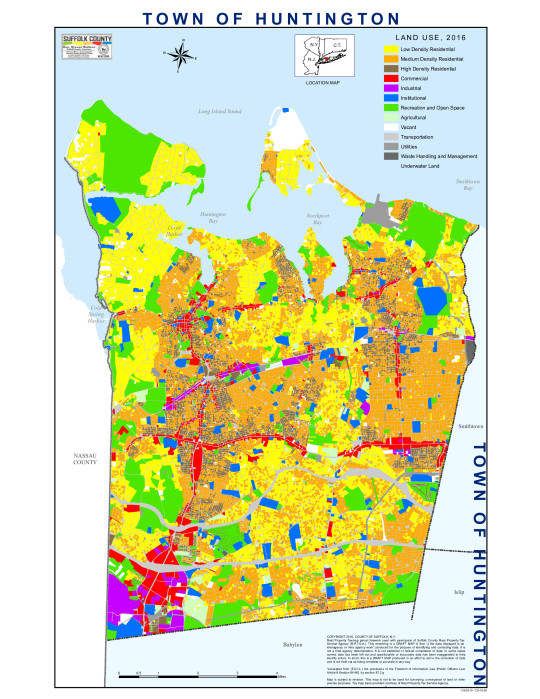
Those red sections are Commercially Zoned areas, and they largely follow some large stroads, most notably Jericho Turnpike (the horizontal line halfway down) and Walt Whitman Road (the vertical line on the left). The bulge where they intersect is Walt Whitman Mall, and the big red chunk in the bottom left is... mostly parking. That central strip, Jericho Turnpike, and its intersection with Walt Whitman... looks like this:

All those red spots are auto dealerships, one after another.
So zoning laws indicate that a dealership (and many other types of commercial properties) can only exist in that little red strip on the land use map, and dealerships take up a lot of space. Not only do they need places to put all of the cars they are selling, but they also need places to park all their customers and employees.
This is where we get into the issue of parking minimums. There is a recent video from Climate Town, with a guest spot by NotJustBikes. If you want to know more about this aspect of zoning law, I'd recommend watching this video and the one linked in the description.
Suffolk county does not have parking minimums. Those are decided on a town or village level. In this case, this means we are looking at the code set for the town of Huntington. (I was originally looking on the county level, and then cut the knot by just asking my real estate agent mom if she knew where I could find minimum parking regulations. She said to look up e360 by town, and lo and behold! There they are.)
(There is also this arcgis map, which shows that they are all within the C6 subset of commercial districting, the General Business District.)
Furniture or appliance store, machinery or new auto sales - 1 per 500 square feet of gross floor area
Used auto sales, boat sales, commercial nurseries selling at retail - 5 spaces for each use (to be specifically designated for customer parking) - Plus 1 for each 5,000 square feet of lot area
This is a bit odd, at first glance, as the requirements are actually much lower than that of other businesses, like drive-in restaurants (1 per 35 sqft) or department stores (1 per 200 sqft). I could not find confirmation on whether the 'gross floor area' of the dealership included only indoor spaces or also the parking lot space allotted to the objects for sale, but I think we can assume that any parking spaces used by merchandise do not qualify as part of the minimum. Some dealerships can have up to 20,000 gross sqft, so those would require 40 parking spaces reserved solely for customers and employees. Smaller dealerships would naturally need less. One dealership in this area is currently offering 65 cars of varying makes and models; some may be held inside the building, but most will be on the lot, and the number may go higher in other seasons. If we assume they need 30 parking spaces for customers and employees, and can have up to 70 cars in the lot itself, they are likely to have 100 parking spaces total.
That's a lot of parking.

Other businesses that require that kind of parking requirement are generally seeing much higher visitation. Consider this wider section of the map:
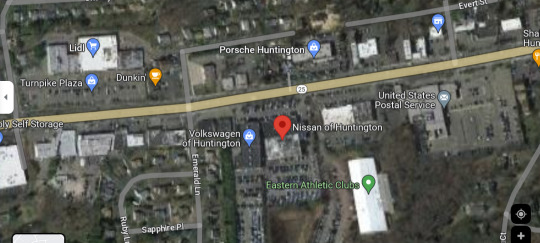
The other buildings with comparative parking are a grocery store (Lidl) and a post office (can get some pretty high visitation in the holiday season, but also just at random).
Compare them, then, to the "old town" section of the same town.
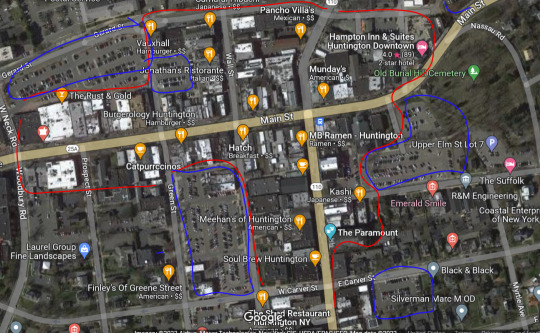
There are a handful of public parking areas nearby (lined in blue), whereas the bulk of the businesses are put together along this set of streets. While there is a lot of foot traffic and vehicle passage, which is appealing for almost any business, opening a car dealership in this area would require not only buying a building, but also the buildings surrounding it. You would need to bulldoze them for the necessary parking, which would be prohibitively expensive due to the cost of local real estate... and would probably get shot down in the application process by city planners and town councils and so on. Much easier to just buy land over in the strip where everyone's got giant parking lots and you can just add a few extra cramped lanes for the merchandise.
Car dealerships also tend to be very brightly lit, which hits a lot of NIMBY sore spots. It's much easier to go to sleep if you aren't right next to a glaring floodlight at a car dealership, so it's best if we just shove them all away from expensive residential, which means towards the loud stroads, which means... all along these two major roads/highways.
And if they're all limited to a narrow type of zoning already, they might as well take advantage of cluster marketing and just all set up shop near each other in hopes of stealing one of the other's customers.
As consumers, it's also better for us, because if we want to try out a few different cars from a few different brands, it's pretty easy to just go one building down to try out the Hyundai and see if it's better than a Chevy in the same price group.
(Prompt me on ko-fi!)
#economics prompts#marketing#zoning laws#ko fi prompts#ko fi#auto industry#automotive dealerships#car dealerships#phoenix posts
110 notes
·
View notes
Text
Consider what cloud capital consists of: smart software, server farms, cell towers, thousands of miles of optic fibre. And yet all of this would be worthless without ‘content’. The most valuable part of the stock of cloud capital is not its physical components but rather the stories posted on Facebook, the videos uploaded to TikTok and YouTube, the photos on Instagram, the jokes and insults on Twitter, the reviews on Amazon or, simply, our movement through space, allowing our phones to alert Google Maps to the latest spot of traffic. In providing these stories, videos, photos, jokes and movements, it is we who produce and reproduce – outside any market – the stock of cloud capital. This is unparalleled. Workers employed by General Electric, Exxon-Mobil, General Motors or any other major conglomerate collect in salaries and wages approximately 80 per cent of the company’s income. This proportion grows larger in smaller firms. Big Tech’s workers, in contrast, collect less than 1 per cent of their firms’ revenues. The reason is that paid labour performs only a fraction of the work that Big Tech relies on. Most of the work is performed by billions of people for free. Sure enough, most of us choose to do this, enjoy it even. Broadcasting our opinions and sharing our lives’ intimate details with our digital tribes and communities seems to satisfy some perverse expressive need of ours. No doubt, under feudalism, serfs toiling away on their ancestral lands would have suffered great hardships but still found it undesirable, if not unfathomable, to have their way of life taken away from them, their shared culture and traditions. Still, the harsh reality remained: at the end of the harvest, the landlord would send the sheriff to extract the lion’s share of their produce – without paying the serfs a penny for it. So it goes with the billions of us unwittingly producing cloud capital. The fact that we do so voluntarily, happily even, does not detract from the fact that we are unpaid manufacturers – cloud serfs whose daily self-directed toil enriches a tiny band of multibillionaires residing mostly in California or Shanghai. This is the crux. The digital revolution may be turning waged workers into cloud proles, who live increasingly precarious, stressful lives under the invisible thumb of algorithmic bosses. And it may have replaced Don Draper with extraordinary behaviour modification algorithms, hidden behind elegant tabletop appliances like Alexa. But that’s not the most significant fact about cloud capital. Cloud capital’s singular achievement, a feat far superior to either of these, is the way it has revolutionised its own reproduction. The true revolution cloud capital has inflicted on humanity is the conversion of billions of us into willing cloud serfs volunteering to labour for nothing to reproduce cloud capital for the benefit of its owners.
~ Yanis Varoufakis: Technofeudalism
#yanis varoufakis#technofeudalism#social media#just see me posting this quote here as a super meta art performance ok#sociology#political science
38 notes
·
View notes
Note
happy birthday! that dither scale you made back in the summer - was that a 4x4 bayer matrix? Also, what image editing software do you use? and for your maquina do mundo, do you have any systems in place for further generation on an extant dataset, such that you could grow an extant world or even specify city locations and build the world around them?
ok lots of questions!
for drawings i use Krita. its open-source and easy to use. for coding i used to use processing, a version of Java with amazing documentation, but now i do everything in C++, using the openFrameworks library
i assume you mean this dither scale. at the time i indeed tried some dithering algorithms but i prefer the Floyd–Steinberg methods. this one instance is a set of tiles. the algorithm averages the luminosity of a small portion of the screen (i think 8x8 pixels) and replaces it.

im not sure what you mean datasets. extant is a funny word tho
the World Machine always generates maps from scratch and then simulates populations based off the existing resources (currently the only resources it looks into is land/sea and rivers).
the starting location for each population is hardcoded, tho it tries to find the best place near it. im currently developing a way to organicaly evolve the population across the map, using the amount of neighborhood tiles in a city and the amount of other cities its connected to, to decide if a city should expande, send migrants to another city or creates a new city
theoretically i could make it load an existing map and keep evolving that, or make it so you can pick the starting locations of each population. however that is not my objective and as such not something im focused on doing
this is going to be my final project for college, and it should run completelly autonomously
3 notes
·
View notes
Text
Road Condition Monitoring System(RCMS): Enhancing Efficiency with AI-Powered Solutions
The quality and sustainability of road infrastructure play a pivotal role in societal development, economic growth, and the safety of communities. To address the challenges of road construction and maintenance, advanced digital tools such as Road Condition Monitoring Systems (RCMS) are becoming indispensable. Leveraging technologies like AI-powered pothole detection, data analytics, and interactive visualization, RCMS ensures efficient planning, monitoring, and maintenance of road networks.

#ai and gis road monitoring solutions#geospatial road management solutions#geospatial road monitoring system#gis based pothole mapping and detection#gis based road condition monitoring system#gis based road inspection software#gis based road survey solutions#gis data analysis for road monitoring#gis mapping for road condition analysis#gis road maintenance solutions#land management system#gis tools for road condition assessment#pothole detection using gis technology#real time road condition monitoring gis#road condition assessment using gis#road condition monitoring using gis#road infrastructure monitoring with gis#road maintenance gis software#road safety monitoring with gis systems#road surface monitoring with gis#smart road condition monitoring gis
0 notes
Text
Topographic Survey Software
AutoPlotter Advanced delivers an affordable solution for everyday land surveying needs. Built on the powerful DTM engine of its Pro counterpart, it seamlessly processes data from total stations, GPS, or similar instruments. Generate professional topographic and contour maps, perform traverse adjustments, and coordinate conversion. Its built-in CAD tools let you create complete drawings, while features like instant map creation and 3D terrain views accelerate your workflow. Easy to learn and use, AutoPlotter Advanced is ideal for surveyors seeking productivity and affordability.
#civil engineering and civil software#topographical survey#land survey#civil technology#mapping software#contour maps
0 notes
Text
Sega Saturn - Shining Force III Scenario 1: The Giant God of King's Landing
Title: Shining Force III Scenario 1: The Giant God of King's Landing / シャイニング・フォースⅢ シナリオ1 王都の巨神
Developer/Publisher: Sega / Sonic! Software Planning / Camelot Software Planning
Release date: 11 December 1997
Catalogue No.: GS-9175
Genre: Strategy RPG


This has to be the best RPG on Saturn. Just beating Grandia in my opinion. Shining Force 3 Scenario 1 is the 1st part of 3. The game features a great storyline, solid 3D towns and maps, and some pretty impressive battle scenes. If you're into RPGs then you must get this one.
Shining Force III, in its Western form, is only one-third of the overall Shining Force III story. In Japan, the game was split into three parts (or "scenarios"); however, in the West, the two latter scenarios were not released, and the subtitle of the first was removed. This can lead to some confusion, as the name Shining Force III can mean both the collection of the three Shining Force III scenarios and/or just this one.





youtube
3 notes
·
View notes
Text
The Scadu of Power Creep
I've anguished at the size of Elden Ring in the past, so it's nice that the Shadow of the Erdtree DLC is in its own little corner that's still extremely large. It's not gargantuan enough to run into a lot of the same issues I had with the base game though. It doesn’t run out of unique content and the path forward is very legible. I'd say this DLC honestly has ideal world design for a souls game. The main path is clear and easy to focus on, but the side content is something you need to really earn. Half of the content in this DLC is side content, and unlike the side stuff in the base game, it's just as good as the required stuff.
Remember Ash Lake in Dark Souls? That hidden area that was hidden behind another hidden area? The one that didn’t really need to be in the game at all? Well, Shadow of the Erdtree has like 5 Ash Lakes and I love it. I love high quality content not just being optional, but something you have to investigate to access. It's fucking insane from a production stand point, but does so much for the magic the world building. This might be the best map From Software has made. It's interconnected in such a way that gives Dark Souls a run for its money, and even having a map doesn't make drawing the mental map in your brain obsolete due to how 3D dimensional everything is.
I'd love the next souls game to be of this size and using the same philosophy as this DLC. The only thing I’d add is a few disconnected areas. Shadow of the Erdtree is great, but it's also not accessible til the end of the base game. I want to see how a game like this lands without having to account for 80 hours of gameplay before starting it. Shadow of the Erdtree has its own level scaling system that powers up your stats through collectibles. This is great for encouraging exploration, as most crafting materials you find at this point in the game are useless. It was a great band aid solution, but I hope they don't have to resort to it again as it does limit the ways you can progress by restricting these materials to certain areas.
The world design is probably the most impressed I was with this DLC, but it doesn't end there. The story is surprisingly easy to follow. Characters are not being cryptic at all here. They are straight forward in letting you know what the deal is. I'm too anxious about the size of these games to stop and appreciate the plot, so this is a welcome approach. The weapons they add to the game are also incredible and made me change up my play style quite a bit. I forever need Martial Arts and Light Great Swords in these games. It’s gonna be hard to go back after playing with them.
There is one thing I’d call a disappointment and that’s the boss design. My complaints aren’t even relevant for most of them. A lot of the DLC bosses are a step up from the base game and are how I'd prefer the boss design to go down in the future. But there were about 4 or so that were kinda ass. Mostly the final boss and the first boss that actually gate keeps you. I just hate how they attack forever. It's not fun for me to play a boss fight where you don't get any openings and trading hits isn't worth it. I basically always had to use summons because I have a job and want to play more than 5 games this year. I've gone through this before in my previous Elden Ring review and it still applies, but this campaign proves that it doesn't have to be this way. 3 of my favorite bosses in the franchise are in this DLC because they don't constantly attack. They find a way to raise the stakes without giving every boss legendary actions.
I think likening the combat to Dungeons and Dragons mechanics is an apt comparison. Not a lot of people know this, but Dark Souls 1 is secretly turn based. Enemies and bosses attack and then take a moment to catch their breath and then you attack and you catch your breath. It sounds boring when you put it that way. But because you always have a turn, you can always do something on that turn. In Elden Ring it's never really your turn when you are fighting these overtuned bosses. And when it is, it's not your turn for long. Thus you have less options to counter attack with because not every attack in this game is quick. This is why I need summons to take aggro off, so I can experiment with other options that aren't a jumping R2 as a counter attack and then dodging 12 times. The average Dark Souls fight I prefer over Elden Ring because there are infinite ways to beat a boss that are valid and effective. And honestly I think Dark Souls 3 is the perfect balance between twitch reflexes and decision making that makes these boss fights great.
I remember spending 3 hours fighting Sister Frieda in the Dark Souls 3 DLC and feeling elated upon victory. It's still one of my favorite boss fights. Because while it's a gauntlet, there's a sober way to deal with everything the boss throws at you and you had time to form a strategy. I understood the boss and that's why I won. I don't think I understood a lot Elden Ring bosses. Not just because I don't have a moment to catch my breath, but also because I can't comprehend what they are doing. This is why I had little fun with the Final Boss. Yea he's hard and aggressive, but also his attacks were literally blinding. I beat him. I liked formulating a strategy to negate the more ridiculous aspects of the fight. But it felt like I didn't completely understand phase 2. So I felt nothing. I spent 3 hours on the fight, just to feel nothing. And if I spent 7 hours doing it without a busted weapon, I might have felt great, but I don’t think it would be worth the payout. This DLC really just hammered how much I like Lies of P fights and how well tuned they are difficulty wise.
I think we have reached Kaizo territory. Bosses are so roided up that instead of feeling triumph I feel like I survived some sick prank. And if people want that, that's fine. Play a mod. This isn't me being snarky. I think the power creep of bosses and trying to make each one harder has gotten out of hand and needs to be dialed back. But for the freaks who still want that, I really think official mod support needs to be in the next souls game so they can be satisfied. Because I don't want the franchise to out grow anyone, not just me. But...I also want the games to be fun to finish, so this seems to be the happy medium. Because Fromsoft won't be able to cater to the freaks for much longer.
2 notes
·
View notes
Note
Have you seen some of the new HDR stuff on KDE plasma 6? Still early days, but very exciting!
https://zamundaaa.github.io/wayland/2023/12/18/update-on-hdr-and-colormanagement-in-plasma.html
oh that is interesting! sounds very promising.
“SDR Color Intensity” is inspired by the color slider on the Steam Deck. For sRGB applications it scales the color gamut up to (at 100%) rec.2020, or more simply put, it makes the colors of non-HDR apps more intense, to counteract the bad gamut mapping many HDR displays do and make colors of SDR apps look more like when HDR is disabled
I guess this goes some way to answering why colour accuracy for SDR content was so dodge when I turned on HDR on windows (which lacks such a slider, just a brightness slider). "the bad gamut mapping many HDR displays do" is big oof but also explains a lot. the mathematics for colour space transformation is pretty well-defined, so if hardware is implementing them incorrectly, that's really frustrating. older screens are working with standards that predate the idea of colour management, but now we're bringing in all these new display signalling standards (PQ and all that), it seems like a golden opportunity to do things properly this time... so of course we don't lmao.
the colorimeter I got has an option for high brightness/HDR screens, but I haven't really tested it yet. 'measure your screen colorimetrically and compensate in software' works decently well in SDR land, but I'm not sure what happens in HDR. I haven't played any HDR-enabled games since I got this colour accuracy bug, so I haven't had cause to try and figure out the ins and outs of it yet.
it seems like KDE intend to be a lot less black-box about it than Microsoft, which is very welcome.
#canmom vs colour#linux#computer science#all this is sutff artists tend to be a lot more concerned about than our audiences in general...
12 notes
·
View notes